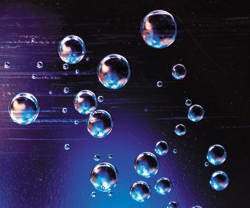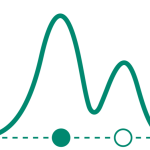
The decision to use disposable bioreactors is now driven by commercial rather than technological considerations.
By Cynthia A. Challener
Single-use bioreactors available from various vendors today are robust and provide the high-performance necessary for commercial manufacturing of biopharmaceuticals. Significant advances in film technologies, bioreactor designs, stirring mechanisms, and sensor systems have contributed to the increasing adoption of disposable reactors from the lab to production scale. Suppliers of single-use bioreactors continue to work closely with customers to address changing needs, such as those for next-generation cell- and gene-therapies and continuous bioprocessing.
“The question of whether to deal with single-use or stainless-steel bioreactors is no longer a technology question, but a commercial one. In other words, does adoption of single-use or stainless-steel bioreactor technology provide greater advantages?” observes Thorsten Adams, director of product management with Sartorius Stedim Biotech. He notes that often for multiproduct facilities with up to 2000 L per bioreactor train, single-use systems are more attractive, while stainless steel or hybrid approaches are typically better suited for large-volume processes for the manufacture of a single product.
Rapid expansion of the single-use bioreactor market supports Adams’ statement. Market research firm Markets and Markets projects the US bioreactor market will increase at a compound annual growth rate of 21.6% from $408.4 million in 2016 to $1.09 billion in 2021 (1).
Measurable progress
“Driven by this high demand, the supply chain for disposable or single-use technologies has become more robust, covering more technologies than before and meeting the growing expectations from our customers,” asserts Morgan Norris, general manager of upstream and cell culture with Cytiva.
Whereas the first disposable bioreactors were ‘plastic’ copies of their stainless-steel counterparts, new generations are redesigned while keeping the end-user, their processes, and their final drug products in perspective, according to Annelies Onraedt, director of marketing for cell culture technologies at Pall Life Sciences. “When considering the workflow and objectives of running bioreactors, recent developments have focused on reducing complexity, improving mixing to achieve higher volumetric mass transfer coefficients (kLa) for oxygen, and avoiding current challenges, such as integrity issues,” she explains.
Improvements in cell-culture processes have led to higher titers and thus higher cell densities, which have facilitated the adoption of single-use bioreactors through reductions in needed reactor volumes. On the other hand, initial single-use bioreactors lacked the power input and mixing capability observed with stainless steel equivalents, according to Onraedt. Leakage and integrity issues also led to reduced confidence in disposable bioreactor technologies for larger-volume applications.
Newer generations of single-use bioreactors have addressed these issues. Pall, for instance, overcame seal housing challenges with the introduction of a large, bottom-driven, elephant ear impellor that also provides the greater power input that high cell density cultures require, according to Onraedt. She also notes that integrity and leakage are now addressed during bioreactor manufacturing and by improving usability/handling of single-use systems. “For example, Pall’s SU bioreactors come with special packaging and an easy-to-implement biocontainer installation method that eliminate the main causes of integrity failures,” she says.
Suppliers have also addressed questions about the films used to produce single-use bioreactors, according to Norris. Many suppliers, including Cytiva, Sartorius, Pall, and Thermo Fisher Scientific, have developed new film platforms. Cytiva’s technology resulted from a strategic alliance with Sealed Air. Film validation using harmonized methods will, in the future, establish a framework for comparison and validation of product contact films for a process, reducing time and effort for the user, notes Onraedt.
Automation and process control, both of which are essential to enabling consistent and reliable biomanufacturing, have improved greatly for single-use bioreactors as well. “Historically, single-use technologies required manual operation and had standalone automation, which created a challenge to control and monitor the entire process train. We have taken automation to the next level, delivering fully automated process trains,” Norris states.
Commercial choice
As such, Norris sees single-use bioreactor processes designed with the entire workflow in mind, delivering a high quality, optimal biologic titer into the downstream unit operation. Adds Adams: “single-use bioreactor technology has matured to the point where suppliers now offer large-scale, robust, well-characterized products that are reliable, scalable, and often preferred over stainless steel.”
These improvements mean that the biopharmaceutical industry has a lot more confidence in single-use technologies today, and the use of them is more widespread, according to Norris. “Previous concerns over business continuity and the regulatory requirements relative to implementation have been addressed, and there are now proven solutions available for customers,” he comments.
In addition, Norris notes that while early adopters limited use of disposable bioreactors to process development or seed train processes feeding large stainless-steel bioreactors due to the 2000 L peak volume for single-use systems, the increased titers of newer cell culture processes, the growth of biologics targeting smaller patient populations and the expanding demand for biosimilars in emerging markets has meant that total output needs now fit within the capable production range of single-use bioreactors.
In fact, an attractive attribute of single-use bioreactors is their full scalability, according to Adams. Today there are systems available for high throughput R&D through to commercial production. Sartorius, for instance, through its acquisition of TAP Biosystems, now offers AMBR mini single-use bioreactors (15-200 mL) operated with a robotic system for rapid evaluation of critical process parameters using minimal material. “Because this technology is scalable, users can quickly scale up optimal reactions to single-use bioreactors in the production environment for reduced time to market,” Adams observes.
Expanding applicability
There are, however, some cases where single-use bioreactors may not be the ideal solution, despite their advantages with respect to reduced setup times and cleaning/cleaning validation requirements. “Sometimes there are unique molecules, or molecules that require such a large output of the biologic that large-volume, stainless-steel bioreactors are more suitable,” says Norris. “Examples include traditional vaccines and blockbuster [monoclonal antibody] (mAb) biologics (>2 metric tons of mAb per year); in these cases, single-use bioreactors might not be the most efficient process to use.”
Single-use bioreactors have also not yet been widely used for microbial fermentation processes. These reactions have a high demand for oxygen and are typically run under pressure with very high gas flow rates, according to Adams. “Single-use bioreactors on the market today generally meet 70% of the performance of their stainless-steel counterparts and thus do not offer a one-to-one process transfer from stainless-steel to single-use systems; compromises and modifications are necessary,” he explains.
The issue: more power is needed to increase the stirring speed and oxygen transfer rate. Suppliers are working on various solutions. Sartorius is developing a new technology and currently is evaluating its performance. Cytiva, meanwhile, recently introduced single-use technologies for microbial fermentation. The system is designed to accommodate the demands of microbial cultures, including mass transfer, mixing, and temperature control, according to Norris.
Cytiva is also developing solutions for vaccine and viral vector manufacturing in single-use bioreactors and is investigating the potential for creating turnkey, biosafety level two (BSL-2) single-use unit operations upstream. The company has also invested $7 million in its single-use manufacturing capabilities in Westborough, MA, shifting the way it develops and manufactures single-use technologies. “This investment highlights our commitment to meet our customer’s current and future requirement needs around single-use technologies and drive faster production development processes internally,” Norris says.
Sensors are improving
The development of robust single-use sensor technology has been one challenge for suppliers of single-use bioreactors. In the past year, however, good single-use sensor technologies have emerged, some of which have become established standards for single-use bioreactors, according to Onraedt. Most common are pH, dissolved oxygen, and carbon dioxide sensors based on fluorescence technology. Others are gaining acceptances, such as capacitance. Newer technologies have more recently been introduced for determination of viable cell mass, glucose, and lactate concentrations.
For instance, Sartorius’ Viamass sensor for online viable cell density determination is available for rocking motion bioreactors and will be available by the end of the first quarter of 2017 for stirred reactors. The data obtained with this sensor are useful for adjusting feed rates in real time and for defining the point for virus injection during vaccine cell culture, according to Adams. Meanwhile, glucose and lactate sensors are useful for determining glucose feeds and monitoring cell metabolism, respectively. “With the range of disposable sensors now available, it is possible to obtain key data in real time without the risk of contamination because physical samples no longer need to be taken from the bioreactor,” Adams states.
The capabilities of software tools associated with single-use sensors are also advancing. Recipe functions and data acquisition and analysis capabilities, including most recently multivariate data analysis, allow for effective monitoring of bioprocesses and provide greater confidence in the user’s ability to determine the optimum operating range, according to Adams.
Perhaps the greatest challenges for single-use sensors are the need to expose them to gamma-radiation during the sterilization process and to extend their lifetimes, particularly for continuous processes, according to Onraedt. Norris agrees that in addition to longer life-times for new processes, the industry is actively seeking single-use sensors with better accuracy and precision. She does note, however, that the state of single-use sensor technology for use with single-use bioreactors in GMP biomanufacturing is constantly improving. “There are several approved biologic manufacturing processes using single-use bioreactors, proving that the current technology meets regulatory requirements,” he says.
Single-use and next-generation biologics
The philosophy behind single-use technologies, including their flexibility and ability to produce smaller batches (reducing the scale for more precise therapies), fits well together with the thinking around cell/gene therapies, according to Norris. “[Cytiva] is taking its experience in single-use bioreactor technologies for monoclonal antibody, recombinant protein, and vaccine processes and applying it in our Xuri line of cell therapy equipment and reagents to support next-generation technologies for new drugs, including scale-up models; regionalizing single-use manufacturing platforms for biologics (increasing local production); and the development of scale-out systems for cell therapy applications,” he notes.
For cell-based therapies, Pall has focused on developing single-use adherent cell-culture bioreactors, which it offers under the XPansion and iCELLis brands. “We have asked three key questions: What is the objective of the cell culture? What is the current workflow with traditional technologies? and What is required from a single-use technology to facilitate this process?” observes Onraedt. “It is not only about doing what has been done previously but in a single-use format; it is also important to look at overall productivities and cost-of-goods reduction,” she adds.
The iCELLis technology, for instance, can replace roller bottles for major vaccine and gene therapy processes, but also dramatically reduce the footprint required to produce the virus titers, and it requires less pDNA to transfect the cells, according to Onraedt. “Single-use bioreactors such as the iCELLis allow rapid process qualification, implementation, and commercialization, providing the speed-to-market that next-generation biologic manufacturers need,” she states.
For the most part, cell- and gene-therapy processes have, to date, been conducted in existing single-use bioreactors. Rocking-motion systems are most widely used in these applications, particularly for autologous cell therapies, according to Adams. “One bioreactor is needed per patient with these patient-specific therapies, which imposes logistics issues that create the need for foolproof tracking systems to prevent material mix-ups. We do expect future developments will address the need for more integrated systems with higher levels of automation. The implementation of Sartorius’ integrated non-invasive biomass sensor in our rocking motion bioreactor gives real-time data on cell health and enables early fault detection, and is a major step towards a fully automated cell-therapy production system,” Adams says.
Continuous impact
The operating conditions for continuous processes must be more robust, and more rigor is required. “Today, a continuous process can last significantly longer than current fed-batch processes, which means that there are higher expectations and a need for a high-level of sensing analytics, providing a secure production process for a longer period of time,” Norris explains. “Understanding how multiple unit operations can be optimized in a continuous setting will also have a major impact on how we develop next generation single-use bioreactors,” he adds.
Continuous processes frequently have higher cell densities, which require better mixing and higher power input, according to Onraedt. “Only the newer generation of single-use bioreactors, such as Pall’s bottom-driven impeller system, have suitable designs to enable achievement of the necessary oxygen transfer rates and kLas,” she says.
Cytiva has invested heavily in its process development capabilities to help optimize cell-line performance, cell-culture media and supplement consumption, and biologic quality in a continuous process. The company plans to go deep into the technical and process details for media consumption and harvest operations to determine how single-use bioreactors can be optimized based on how these operations vary, according to Norris.
In addition to developing robust single-use bioreactors, Sartorius developed its new kSep technology to ensure optimized power efficiency during continuous operation. The company has also focused on developing single-use bioreactors that can interface with devices, such as cell retention devices, from different manufacturers and that contain sterile connections for integration with both single-use and stainless-steel sensors. Its control system can also be integrated with different user systems. Sartorius has also introduced a new single-use centrifugation system that allows product recovery from the material removed during the cell bleed step. Currently, this product is typically discarded with the used cells.
Reference
1. Markets and Markets, “Single-use Bioreactors Market worth 1,085.7 Million USD by 2021,” Press Release (October 2016).





